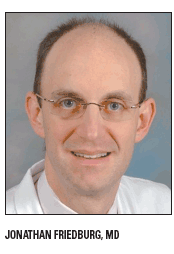Drug with tumor-specific target fells cancerous B cells while sparing healthy ones in NHL
A novel drug that targets an important protein receptor that supports B-cell lymphoma cells produced significant responses in non-Hodgkin’s lymphoma patients who had failed prior therapies. Results from the phase II trial of fostamatinib disodium in 68 heavily pretreated relapsed and refractory B-cell NHL patients revealed that the treatment has significant promise and should undergo further clinical testing, according to lead investigator Jonathan W. Friedberg, MD, of the James P. Wilmot Cancer Center at the University of Rochester in New York.
A novel drug that targets an important protein receptor that supports B-cell lymphoma cells produced significant responses in non-Hodgkin’s lymphoma patients who had failed prior therapies. Results from the phase II trial of fostamatinib disodium in 68 heavily pretreated relapsed and refractory B-cell NHL patients revealed that the treatment has significant promise and should undergo further clinical testing, according to lead investigator Jonathan W. Friedberg, MD, of the James P. Wilmot Cancer Center at the University of Rochester in New York.

Fostamatinib disodium targets a protein receptor known as SYK (spleen tyrosine kinase) that is crucial for the survival of cancerous B cells.
“Because it has a tumor-specific target, it could potentially kill tumor cells while leaving normal cells alone, allowing for decreased side effects,” Dr. Friedberg said. The drug targets an entirely different pathway than do currently approved medications and might be a welcome addition to the arsenal of drugs used to treat lymphoma patients who have failed standard chemotherapies, he added.
In the clinical trial of fostamatinib disodium, the drug was given at a dose of 200 mg twice daily to patients in three groups: those with diffuse large B-cell lymphoma, those with follicular lymphoma, and those with other B-cell NHL including chronic lymphocytic leukemia/small lymphocytic lymphoma (CLL/SLL), mantle cell lymphoma, MALT lymphoma, and lymphoplasmacytic NHL. Patients had received an average of five previous therapies, and many had previously received an autologous stem cell transplant or radioimmunotherapy (ASH 2008 abstract 3).

The response rates were as follows: 22% in diffuse large B-cell NHL; 10% in follicular lymphoma; 55% in CLL/SLL; and 11% in mantle cell lymphoma.
Stable disease was also seen in an additional 23 patients: 12 with follicular lymphoma, four with diffuse large B-cell lymphoma, four with mantle cell lymphoma, two with CLL/SLL, and one with MALT lymphoma.
Some of these responses were prolonged, with some patients remaining on therapy for over one year, Dr. Friedberg said. The safety profile of the drug was also favorable given the refractory nature of the patients’ lymphoma. There were four cases of febrile neutropenia, and eight patients required a dose modification because of neutropenia, hypertension, liver function test abnormalities, fever, or mucositis.
“Very few patients had to be hospitalized because of complications and that’s significant, because these are patients for whom the therapeutic options are limited.” Dr. Friedberg said. Current plans call for additional clinical trials of fostamatinib disodium in NHL, as well as laboratory investigations to further explain the interaction of SYK and B cell survival, he added.